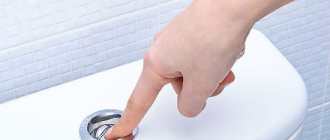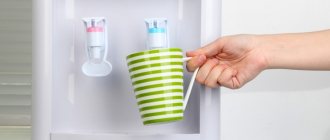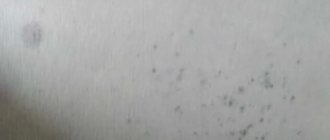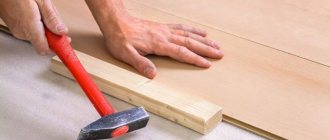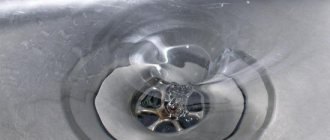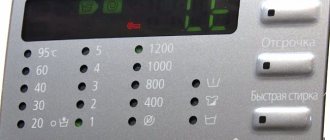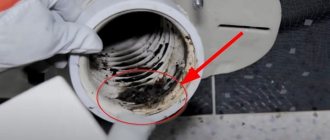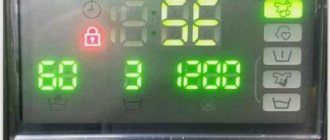Laminate flooring can swell for a variety of reasons. But often this happens after prolonged contact with water. It is necessary to respond to such damage as quickly as possible, which will allow the defect to be eliminated locally, with minimal cost. Otherwise, you will have to do a major overhaul - completely change the laminate. To avoid such situations, you should properly care for the floor covering and promptly remove accidentally spilled liquid from the surface.
Subject to the rules of operation and maintenance, laminate flooring retains its original appearance for many years Source p0.zoon.ru2
Why does it swell?
The slightest swelling of the laminate in the room is very noticeable, especially if it happens in the area of the seams. It is not always possible to save swollen floor material without disassembling; in difficult cases, you have to resort to major repairs. Often the lamellas are damaged for the following reasons:
- Incorrect installation. Swelling of the coating without any signs of flooding most likely indicates a lack of proper waterproofing or compensating gaps.
- Failure to comply with floor care rules. If a small volume of water remains on the floor surface for a long time, the laminate will partially swell. In this case, it will be possible to replace only a few damaged elements.
- Flooding of housing. In the event of an accident, liquid should be removed from the flooring as quickly as possible. If this can be done within an hour, the risk of damage to the base is significantly reduced.
Important! A high-quality expensive laminate can withstand some time (up to 15 hours) in a humid environment without further loss of appearance.
Sometimes laminate flooring swells due to improper preparation of the base base. Source liveposts.ru
The condition of the laminate flooring after flooding will largely depend on how properly it was cared for before. Periodic treatment with protective mastics significantly increases its chances of maintaining its characteristics after an accident. In addition, it is much easier to restore a well-maintained laminate: the mastic film does not allow water to penetrate into the structure of the cellulose base; this only happens in the area of worn or overloaded locking joints.
After applying mastic, the laminated coating acquires valuable water-repellent properties Source img.ruud.ru
Methods of protection against moisture exposure
Moisture is the only and very dangerous enemy of laminate, which can damage it in a short time.
Various means are used to protect the material from its effects.:
- Glue. It is used when assembling the canvas, although it is usually done without it. The glued locking part resists moisture well, but dismantling the coating if necessary will be very difficult.
- Wax impregnations or mastics. They impregnate laminate joints, which are most susceptible to moisture. The seams are impregnated with the compounds, the excess is removed with a clean, dry cloth.
- Sealant. It is applied to the bottom of the lock joints during assembly. If it gets on the front side, you must immediately remove it with a dry cloth, otherwise the sealant will harden.
- Protective film. You need to know how to apply it, but when laid evenly and without bubbles on the surface, it creates a high-quality and good-looking protective layer.
All of the above protection options are effective to one degree or another, but they also have disadvantages. They mainly relate to problems with application and relatively low efficiency .
Laminate repair without disassembly
If the slatted floor covering has been exposed to moisture for several days, it will most likely need to be completely replaced. Many people can dry a very wet floor if the following conditions are met:
- Lack of furniture in the room.
- Availability of heating devices, the operation of which can be regulated.
- There are no drafts inside the room.
- The flooring base is a material made from pressed pine needles.
- The laminate flooring is laid on top of a wood base, and there are special vents (gaps for ventilation) underneath it.
Purchasing recommendations
In most cases, laminated floor coverings are fancy materials that require special care and treatment. However, the resulting surface looks so attractive that buyers often turn a blind eye to the shortcomings. Still, it should be noted that, along with the others, there are samples that can be resistant to water and mechanical damage. So, if you wish, you can always choose an option that is suitable for any room category, and can also satisfy the requirements of each consumer. You can get an attractive-looking floor surface without paying a high price.
But you should be prepared for the fact that it is worth hiring specialists with work experience and the necessary technical base to assemble such structures. In addition, the further operation process will be associated with many conventions that will need to be strictly observed.
Eliminating swelling of laminate flooring at joints
The end lock connecting the panels is the most vulnerable point. It absorbs most of the spilled liquid. The surfaces of the panels are more protected, as they are covered with polyurethane or vinyl film. Typically, water penetrates into the structure of the material only a couple of millimeters, which is enough to cause the elements to swell and deform. During drying, damaged areas of the floor must be loaded, otherwise they will remain uneven forever.
Sequencing:
- Open the lock: using a tool, separate the tongue and groove. This will allow sufficient access to the ends.
- Dry the area where the material is swollen with a hair dryer, turning off the heating device.
- Experts recommend using an iron only in rare cases (in case of severe delamination of the material). Then the locking joint and all the cracks at the end are covered with PVA emulsion, then dried with a heating device. In this case, heat-resistant material should be used.
Helpful information! There are laminate locks containing special silicone inserts. They seal the temperature gap and protect the joint from water penetration. Despite the fact that this design was created quite recently, it has already shown high efficiency in the bathroom and kitchen.
In order to properly dry wet laminate, it is important to gain access to the inner surface of the locks Source stroy-podskazka.ru
Causes
Laminate is a floor covering that consists of individual panels assembled into a single sheet. This installation method allows you to create coverings of any area, and, in most cases, this can be done alone .
At the same time, the heterogeneity of the fabric means the presence of a large number of small cracks and gaps that are difficult to see, but are quite sufficient for moisture. If the laminate is laid in violation of the technology, then the sizes of individual panels will begin to increase from moisture absorption, which will cause swelling in certain areas of the coating.
There will be nothing to compensate for the expansion of the panel, so it will simply be pushed up.
The main causes of bloating are considered to be:
- Moisture getting under the material or in the cracks between the panels.
- Poor quality laminate.
- The base is not insulated from capillary moisture.
- Installed moldings or thresholds that tightly fix the material in one line and do not allow it to move during expansion.
Swelling of the laminate base is the main and almost the only reason for swelling of the coating. Temperature expansions are also possible, but they do not create such strong changes in size, in addition, they require certain conditions.
Practice shows that the conditions under which the swollen material was operated always did not meet the humidity requirements, so we will consider this option.
If there are violations of the installation technology, in particular, there is no waterproofing of the base, as a result of which moisture is allowed to penetrate into the load-bearing layer from below, then no methods can be used to solve the problem; only dismantling the coating, installing waterproofing and re-installation will help.
Poor quality material is an incurable disease, and if it swells, this is most often a signal for replacement. A supporting layer that is not resistant to moisture will constantly swell and spoil the appearance of the canvas.
The same is with thresholds or moldings - if they interfere with the movement of the canvas, elastic gaskets should be installed under them, and larger diameter holes should be drilled in the places where the screws pass , allowing the movement of the laminate.
What to do when laminate flooring is swollen from water
Laminate flooring is distinguished by a special design: with proper installation, the layer of lamellas remains in a free position. Therefore, minor changes in humidity or temperature do not worsen the condition of the floor surface. If the material gets wet and then swells, it means that it has already partially dried, but some parts of it are still wet.
If the laminate is swollen by waves after water, in the summer it is enough to wipe the surface with a dry cloth and properly ventilate the room Source stroy-podskazka.ru
It is possible to save wet panels with proper drying. It should be done this way:
- Remove furniture from the room.
- Remove the baseboards.
- Along the line of contact of the panels (approximately 15 cm from the wall), cut the lock with a knife, lift the edge of the lamella or remove it completely. This will ensure better drying of the lining material. Removing a few laminate strips will help settle warped joints.
- Install a household fan (away from heavily damaged areas) and start drying the room with a slight draft. With a device productivity of 200 m3/h, moisture can be eliminated in just a couple of days.
- After 12 hours, level the swollen laminate: load heavily raised areas with pressure (about 15 kg per 1 m2).
Attention! Heating the room will not help remove moisture from laminate flooring. In conditions of excessive humidity and high temperature, it arches. When drying the floor, it is important to maintain the geometry of the lamellas and prevent their delamination or deformation.
Removing laminate panels is the only way to effectively remove residual water under the coating Source i.gardendecorgalore.com
Operating rules
Higher quality models of laminated coatings are more expensive; they fit perfectly together and do not allow moisture to pass through at the joints. However, violation of operating rules (especially when it comes to wet cleaning methods) can lead to moisture penetration under the top layer of the material. And the MDF base contains wood fibers that are subject to deformation when in contact with water. Contact of high temperature sources with the laminate surface must be avoided. Particularly sudden heating can also cause the surface to swell.
Replacing laminate flooring
If the drying process does not bring the expected result, the damaged laminate will have to be removed. You should start disassembling the floor only after it has dried a little. This will greatly facilitate the process of opening the locks. Dismantled parts are sorted according to the severity of damage; completely unusable elements are disposed of. It is recommended to moisten swollen areas (without cracks or delamination), cover them with paper, and then place them under load on a flat base. Drying and leveling of the material usually take two weeks.
During re-installation, slats that have lost their proper dimensions are attached in less noticeable places (under pieces of furniture). Often they have to be secured using dowels and adhesive. The remaining elements are laid according to the manufacturer's instructions. Wet lining material must be replaced. If a damaged lock does not allow a full connection to be made, the excess part of the end must be removed with a knife, then carefully align the joint. In such areas it is advisable to use polyurethane glue.
Laminate flooring is dismantled only in cases where it is swollen by more than 20% of the floor surface Source laminat-msc.ru
Weight application
If you try to press a bulge on the floor with a weight, you may encounter other unpleasant consequences. In nine cases out of ten, a section of the swollen surface will simply move to another place. To level the surface, you should resort to a different technique, which largely depends on the cause of the damage.
If problems arise with laminate flooring, the first step is to remove any obstructions that may prevent the laminate from spreading. Next, you should check for the presence of a technological gap along all walls. If the surface of the coating rests against the wall in at least one place, this can also cause the laminate to swell.
It is worth remembering that the required gap should not be less than 5 millimeters. If, after removing all obstacles, the surface does not begin to level, it is necessary to open the areas of swelling. After removing one of the components of the coating, it is worth inspecting the substrate for moisture accumulation. In some cases, it is advisable to replace the substrate in order to understand how to restore the laminate that has swollen from water.
How to prevent bloating
Expensive laminate products treated with wax impregnation are not at all afraid of liquids. Practice shows that the measures provided by the manufacturer are quite effective. For such a laminate to swell from water, it requires heavy flooding for at least five hours or the formation of condensation on the concrete base of the floor.
The use of any laminate coating over time leads to wear of the locks. After a few years, the expensive material will be no different from ordinary material in terms of water resistance. Therefore, the laminate must be periodically coated with protective mastic. In addition, it is recommended to seal the gaps under the baseboards with transparent silicone. Then the strength of the seams will be sufficient to hold the coating in place when the floor gets wet or slightly bulges. The accumulation of condensation under the laminate can be avoided if the base is covered with acrylic primer.
Polishes and impregnations that contain wax have a water-repellent effect and reliably protect the laminate from moisture during regular processing Source pol-exp.com
Possible types of defects
Local swelling
A slight swelling in the center of the board indicates local exposure to moisture on the damaged area. The cause of the problem is spilled liquids that have seeped into an existing deep scratch. Moisture penetrates into the supporting layer, which leads to deformation of the entire floor.
Small swellings
Wave formation
Wave-like curvatures of the surface appear due to the absence or insufficiency of compensation gaps within one room. If all installation conditions are met, then only poor quality lamellas can swell.
Wave-like deformations of the surface
Another reason for the appearance of waves is the laying of too long a continuous covering when installing a floor without thresholds throughout the apartment. Seams existing only along the walls are not enough to compensate for the thermal expansion of the boards - for this reason, the laminate swells.
Laying without breaks is only allowed up to 10 m in length and 8 m in width. For the kitchen and bathroom - up to 8 and up to 6 m, respectively.
Also, waves on the surface appear due to incorrect selection of the thickness and material of the substrate. Laying thin boards on too thick a lining is not allowed, and vice versa. And for heated floors a special underlay is required.
Deformation of lamellas at joints
In rooms with high humidity, floors may swell where the boards join each other. The same defect is observed due to excessive wetting of the floor with water during cleaning. Swelling can be prevented by treating the joints with wax or sealant. The high density of the lamellas and the resistance of the joints to mechanical stress also increase moisture resistance.
Deformation of panels at joints
Useful tips
When installing laminate flooring, the first step is to choose the right underlay material. The best option is a panel of compacted pine needles. It perfectly allows water vapor to pass through, so if it is flooded, drying the floor on such a lining will not be difficult. If you need to re-lay the flooring, the coniferous underlay will have to be replaced, and popular cork sheets can be dried in the open air, first covered with paper. Cork practically does not absorb moisture, but at the same time it collects foreign odors. Therefore, after removing expensive building materials, it is advisable to clean them with water, after adding a little hydrogen peroxide to it.
Design
If you decide to deal with laminate yourself, you need to understand how it works. The panel is based on a fiberboard or chipboard board, on both sides of which there are small locking connectors to allow the boards to be connected during installation. The strength of the coating depends on the thickness of this layer. On its lower side there is a protective layer. It resembles a thick sheet of paper, which is covered on one side with a waterproof film and protects against moisture penetration.
There is a decorative layer on the top of the fiberboard. This is paper with a design on it. The paper is covered with a melamine layer and a layer of acrylic resins. This coating protects the slab from external influences, and the better it is, the better the protection and, therefore, the higher the price of the laminate.
Manufacturers may add additional layers: real wood veneer, backing, protective face covering or waterproof shell. Naturally, adding layers entails an increase in the cost of the facing material.
Gap between other elements
An example of closing the expansion gap between a pipe and a laminate
Since we are talking about the compensation gap, you should not forget to observe it not only when retreating from the wall, but also when installing other elements and communications in the room.
Often such elements are door latches, heating pipes, furniture legs and others.
If you install a door stop, it should be attached not to the laminate itself, but to the concrete base, that is, to the screed. In this case, it is necessary to drill a hole with diameters equal to the compensation gap and select the design of the limiter so that it closes this hole.
Cunning!
When bypassing and closing the joints of heating pipes, a gap is also left equal to the expansion joint; after completion of the work, it can also be covered with decorative overlays and it will not be visible.
If some parts of the room decoration also need to be securely fastened to the floor by screwing, we also recommend doing this not to the covering but to the base, that is, to the screed, through the same drilled holes, the size of which should not be less than the thermal gap from the walls and in this case, you won’t have any questions about why the laminate is swollen.
Foreign attachments to the base
Floor door stop with a wide base is attached to the screed and not to the laminate
It also happens that unfortunate builders, as a result of their illiteracy, nail the laminate with nails or screw it to the base with cuts. In such a situation, the laminate will also swell at the joints, since in any case, when the air humidity in the room changes, it must “walk” and this is inevitable.
If for some reason you find such a structure on your floor, immediately clear the floor of these couplings. And after literally 2-3 days, the laminate should settle down to a flat surface on its own. The decisive factor in such a situation will be the timely detection of this problem and its elimination. If you notice this too late, it will not be possible to eliminate such a defect and you will have to replace the entire floor.



